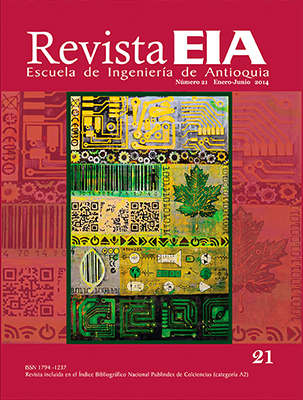TRATAMIENTO DE LODOS DE FONDO DE LAGUNAS FACULTATIVAS CON ESTABILIZACIÓN EN CONDICIONES DE LABORATORIO
TRATAMIENTO DE LODOS DE FONDO DE LAGUNAS FACULTATIVAS CON ESTABILIZACIÓN EN CONDICIONES DE LABORATORIO
Barra lateral del artículo
Términos de la licencia (VER)

Esta obra está bajo una licencia internacional Creative Commons Atribución-NoComercial-SinDerivadas 4.0.
Declaración del copyright
Los autores ceden en exclusiva a la Universidad EIA, con facultad de cesión a terceros, todos los derechos de explotación que deriven de los trabajos que sean aceptados para su publicación en la Revista EIA, así como en cualquier producto derivados de la misma y, en particular, los de reproducción, distribución, comunicación pública (incluida la puesta a disposición interactiva) y transformación (incluidas la adaptación, la modificación y, en su caso, la traducción), para todas las modalidades de explotación (a título enunciativo y no limitativo: en formato papel, electrónico, on-line, soporte informático o audiovisual, así como en cualquier otro formato, incluso con finalidad promocional o publicitaria y/o para la realización de productos derivados), para un ámbito territorial mundial y para toda la duración legal de los derechos prevista en el vigente texto difundido de la Ley de Propiedad Intelectual. Esta cesión la realizarán los autores sin derecho a ningún tipo de remuneración o indemnización.
La autorización conferida a la Revista EIA estará vigente a partir de la fecha en que se incluye en el volumen y número respectivo en el Sistema Open Journal Systems de la Revista EIA, así como en las diferentes bases e índices de datos en que se encuentra indexada la publicación.
Todos los contenidos de la Revista EIA, están publicados bajo la Licencia Creative Commons Atribución-NoComercial-NoDerivativa 4.0 Internacional
Licencia
![]()
Esta obra está bajo una Licencia Creative Commons Atribución-NoComercial-NoDerivativa 4.0 Internacional
Contenido principal del artículo
Resumen
RESUMEN
En este artículo se muestran los resultados obtenidos en el proceso de estabilización química de lodos de lagunas de estabilización, mediante la adición de cal hidratada común. Se adicionaron en condiciones controladas de laboratorio, dosis de cal al 5 %, 7 %, 9 %, 10 %, 11 %, 12 % y 15 % a una muestra de lodos de fondo de la laguna primaria del sistema de tratamiento de aguas residuales de la ciudad de Montería, Colombia. Se analizaron la peligrosidad del lodo (corrosividad, inflamabilidad y reactividad) y las concentraciones de sulfuros, metales pesados (As, Ba, Cd, Cr, Hg, Ag, Pb, Se), coliformes, salmonella, bacterias mesófilas, áscaris y otros helmintos, antes y después de aplicar una dosis optima al 10%. Con esta dosis se logró controlar la reactividad por sulfuros y cianuros, pero no se redujeron las concentraciones de coliformes y de bacterias mesófilas. Algunos metales pesados (Cd, Cr, Hg, Ag, Pb) aumentaron luego de la aplicación de la dosis de cal hidratada, aunque las concentraciones halladas no constituyen peligro ambiental, de acuerdo a la normatividad ambiental vigente.
ABSTRACT
In this paper we show the results obtained in the chemical stabilization process of pond sludge by adding common hydrated lime. Dosages of 5%, 7%, 9%, 10%, 11%, 12% and 15% were added in controlled laboratory conditions to a sample of sludge taken from the bottom of the primary facultative pond of the wastewater treatment system of Monteria in Colombia. Dangerousness (corrosivity, flammability and reactivity) and concentrations of sulfides, heavy metals (As, Ba, Cd, Cr, Hg, Ag, Pb, Se), coliforms, salmonella, ascaris and other helminths were analyzed in the sludge sample, before and after the application of an optimal 10% dosage. The reactivity by sulfides and cyanides in the sludge sample was controlled with this dosage, however, coliforms and mesophilic bacteria concentrations did not decrease. Some heavy metals increased (Cd, Cr, Hg, Ag, Pb) after the application of hydrated lime dosage, although the concentrations found are not representing environmental danger according to existing environmental regulations.
Descargas
Detalles del artículo
Jhon Jairo Feria Diaz, Universidad Pontificia Bolivariana
Ingeniero sanitario. MsC.en Ciencias Ambientales. Docente Facultad de Ingeniería Sanitaria y Ambiental. Coordinador del Grupo de Investigaciones de Calidad de Aguas y Modelación Hídrica y ambiental-CAMHA. Universidad Pontificia Bolivariana, seccional Montería, Montería (Colombia).
Luisa Elvira Martinez Acosta, Universidad Pontificia Bolivariana
Ingeniera civil. MsC. en Ingeniería Civil con énfasis en Ambiental. Docente Facultad de Ingeniería Civil. Universidad Pontificia Bolivariana, Seccional Montería, Montería (Colombia).


 PDF
PDF
 FLIP
FLIP


